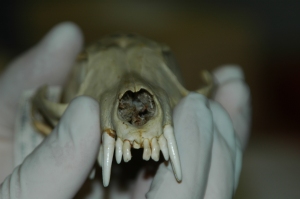Much of my research has been centered on the red fox. This widespread yet understudied species is a great model system for the study of large scale phylogeography and evolution. Phylogeographic work by my colleagues and I is the foundation for a host subsequent studies (some of which I have listed below).
Products (representative examples)
McDevitt AD, Coscia I, Browett SS, Ruiz- González A, Statham MJ, et al. 2022. Next-generation phylogeography resolves post-glacial colonization patterns in a widespread carnivore, the red fox (Vulpes vulpes), in Europe. Molecular Ecology, 31:993–1006.
Statham MJ, Edwards CJ, Norén K, Soulsbury CD, Sacks BN (2018). Genetic analysis of European red foxes reveals multiple distinct peripheral populations and central continental admixture. Quaternary Science Reviews. 197: 257-266. https://doi.org/10.1016/j.quascirev.2018.08.019
Sacks BN, Statham MJ, Lounsberry Z. Nuclear genetic analysis of the red fox across its trans-Pacific range. Journal of Heredity. https://doi.org/10.1093/jhered/esy028
Kasprowicz A, Statham MJ, Sack BN. (2015) The fate of the other red coat: remnants of colonial British red foxes in the Eastern United States. Journal of Mammalogy.
Norén K, Statham MJ, Ågren E, Isomursu M, Flagstad Ø, Eide NE, et al. (2015) Tracking genetic footprints to reconstruct geographic patterns of expansion in Fennoscandian red foxes. Global Change Biology.
Berteaux D, Gallant D, Sacks BN, Statham MJ. (2015) Red foxes (Vulpes vulpes) at their expanding front in the Canadian Arctic have indigenous maternal ancestry. Polar Biology.
Statham MJ*, Murdoch J, Janecka J, Aubry KB, Edwards JE, Soulsbury CD, et al. (2014) Range-wide multilocus phylogeography of the red fox reveals ancient continental divergence, minimal genomic exchange, and distinct demographic histories. Molecular Ecology, 23: 4813–4830.
Statham MJ*, Sacks BN, Aubry KB, Perrine JD, Wisely SM (2012) The origin of recently established red fox populations in the contiguous United States: translocations or natural range expansions? Journal of Mammalogy, 93(1): 52-65.
Statham MJ*, Rich AR, Lisius SK, Sacks BN (2012) Discovery of a remnant population of Sierra Nevada red fox (Vulpes vulpes necator). Northwest Science, 86(2): 122-132.
Sacks BN, Statham MJ, Perrine JD, Wisely SM, Aubry KB (2010) North American montane red foxes: expansion, fragmentation, and the origin of the Sacramento Valley red fox. Conservation Genetics, 11: 1523-39.
Aubry KB, Statham MJ, Sacks BN, Perrine JP, Wisely SM (2009) Phylogeography of the North American red fox: vicariance in Pleistocene forest refugia. Molecular Ecology, 18: 2668-2686
Work on other Canid Species
Sacks BN, Statham MJ, Serieys LEK, Riley SPD. 2022. Population genetics of California gray foxes clarify origins of the island fox. Genes
Sacks BN, Mitchell KJ, Quinn CB, Hennelly LM, Sinding MHS, Statham MJ et al. 2021. Pleistocene origins, western ghost lineages, and the emerging phylogeographic history of the red wolf and coyote. Molecular Ecology. 30: 4292-4304. Cover article.
Gulsby WD, Killmaster CH, Bowers JW, Kelly JD, Sacks BN, Statham MJ, et al. (2015) White-tailed deer fawn recruitment before and after experimental coyote removals in central Georgia. Wildlife Society Bulletin.
Past projects
The origin of domesticated silver foxes

Anna Kukekova, University of Illinois at Urbana-Champaign
Products
Statham MJ*, Trut LN, Sacks BN, Kharlamova AV, Oskina IN, Gulevich RG, Johnson JL, Temnykh SV, Acland GM, Kukekova, AV (2011) On the origin of a domesticated species: identifying the parent population of Russian silver foxes (Vulpes vulpes). Biological Journal of the Linnean Society, 103: 168–175.


